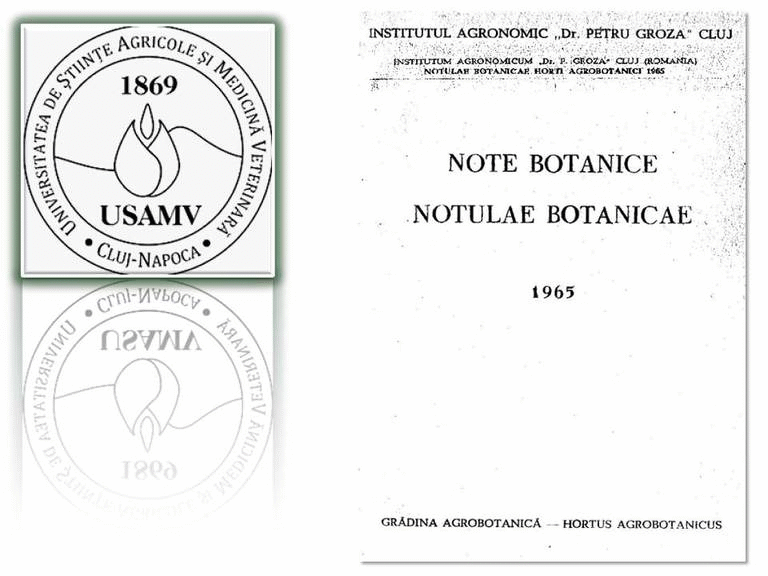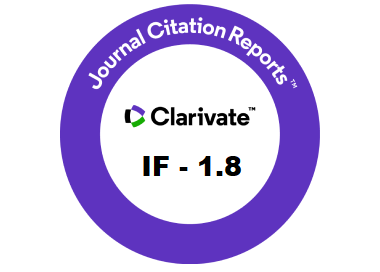Characterization of palm date varieties (Phoenix dactylifera L.) growing in Saudi Arabia: Phenotypic diversity estimated by fruit and seed traits
DOI:
https://doi.org/10.15835/nbha51112996Keywords:
date palm (Phoenix dactylifera L.), Pearson r correlation (PRISM Graphpad, San Diego USA), PCA, phenotypic diversity Saudi palm date cultivars, UPGMAAbstract
In order to determine the variation and the degree of diversity among the most well-known Saudi date palm (Phoenix dactylifera L.), this study applied various widely detectible fruit and seed features. The properties of the fruit and seeds were described using ten phenotypic traits. Eighteen date palm varieties from six production sites were used in this study (Ḥaʼil, Al-Madina, Al-Hassa, Al-Qassim, Kharaj, Najran). The data was analysed by Pearson r correlation. The principal components analysis (PCA) and UPGMA clustering were used to analyse the data set. According to PCA, the results showed significant variation among the analysed varieties. Our data shows that seed ratio varies among all varieties. The mean seed weight ratio varies between 4 and 13%. Varieties ‘Raziz’, ‘Lubab’ and ‘Wasily’ demonstrate higher seed ratio (over 10%). Whereas, Fankha depicts a 5 and 4% fresh and dry seed ratio. The statistical analysis indicates that the seed ratio in all 18 varieties is comparable in fresh and dry fruits. The result suggests variation among the numerous features due to dissimilarities and heterogeneity. However, the obtained results also propose the clustering and grouping of closely related features, e.g., weights of fresh and dry fruits. Eventually, it is suggested to conduct additional research on Saudi date palms utilizing more phenotypic traits in order to have a better understanding of the pack of morphological descriptors.
References
Abdul JC, Shyam SK, Sreeramanan S (2015). Variations in hormones and antioxidant status in relation to flowering in early, mid, and late varieties of date palm (Phoenix dactylifera) of United Arab Emirates. Scientific World Journal 2015:846104. https://doi.org/10.1155/2015/846104
Abdul-Hamid N, Ashikin M, Nur HM, Mediani M, Ismail A, Intan ST, Chau L, Shadid K, Abas F (2020). Quality evaluation of the physical properties, phytochemicals, biological activities and proximate analysis of nine Saudi date palm fruit varieties. Journal of the Saudi Society of Agricultural Sciences 19:151-160. https://doi.org/10.1016/j.jssas.2018.08.004
Abdulla M, Gamal O (2010). Investigation on molecular phylogeny of some date palm (Phoenix dactylifera L.) cultivars by protein, RAPD and ISSR markers in Saudi Arabia. Australian Journal of Crop Science 4(1):23-28.
Ahmed M, Bouna ZEO, Lemine FMM, Djeh TKO, Mokhtar T, Salem AOM (2011). Use of multivariate analysis to assess phenotypic diversity of date palm (Phoenix dactylifera L.) cultivars. Scientia Horticulturae 127(3):367-371. https://doi.org/10.1016/j.scienta.2010.11.011
Alaida MF, Aldhebiani AY (2022). Comparative study of the morphological characteristics of Phoenix dactylifera L. cultivars in Al-Madinah Al-Munawarah-Saudi Arabia. BMC Plant Biology 22:461. https://doi.org/10.1186/s12870-022-03841-0
Al-Farsi MA, Lee CY (2008). Nutritional and functional properties of dates: a review. Critical Reviews in Food Science and Nutrition 48:877-887. https://doi.org/10.1080/10408390701724264
Alhudaib KA, El-Ganainy SM, Almaghasla V, Sattar MN (2022). Characterization and control of Thielaviopsis punctulata on date palm in Saudi Arabia. Plants 11:250. https://doi.org/10.3390/plants11030250
Aljuhani WS (2016) Genetic diversity and the impact of geographical location on the relationships between Phoenix dactylifera L. Hereditary Genetics 5:3. https://doi.org/10.4172/2161-1041.1000172
Al-Khalifah NS, Askari E, Shanavas Khan AE (2012). Molecular and morphological identification of some elite varieties of date palms grown in Saudi Arabia. Emirates Journal of Food and Agriculture 24(5):456-461. https://www.ejfa.me/index.php/journal/article/view/913
Allam A, Djafri K, Bergouia M, Khemissat E, Tama M, Taleb B (2021). Morphological and physicochemical characterization of date palm cultivars from Ghardaïa (Southeast Algeria). Journal of Applied Life Sciences and Environment 1(185):12-24. https://doi.org/10.46909/journalalse-2021-002
Almadini AM, Ahmed IHI, Faleh AA (2021). Assessment of farmers practices to date palm soil fertilization and its impact on productivity at Al-Hassa oasis of KSA. Saudi Journal of Biological Sciences 28:1451-1458. https://doi.org/10.1016/j.sjbs.2020.11.084
Al-Shahib W, Marshall RJ (2003). The fruit of the date palm: its possible use as the best food for the future? International Journal of Food Sciences and Nutrition 54:247-259. https://doi.org/10.1080/09637480120091982
Anonymous (2006). The famous date varieties in the Kingdom of Saudi Arabia (Ed. Ministry of Agriculture, Kingdom of Saudi Arabia and Food and Agriculture Organization of the United Nations). pp 245.
Baliga MS, Shivashankara AR, Haniadka R, Dsouza J, Bhat HP (2011). Phytochemistry, nutritional and pharmacological properties of Artocarpus heterophyllus Lam (jackfruit): a review. Food Research International 44:1800-1811. https://doi.org/10.1016/j.foodres.2011.02.035
Basu S, Sengupta R, Zandi P (2014). Arecaceae: The majestic family of palms. Encyclopaedia of Earth 29:831-842. https://doi.org/10.9755/ejfa.v25i11.16660
Ben Ismaïl H, Djendoubi N, Kodia A, Ben Hassine D, Ben Slama M (2013). Physicochemical characterization and sensory profile of 7 principal Tunisian date cultivars. Emirates Journal of Food and Agriculture 25(5):331-341. https://doi.org/10.9755/ejfa.v25i5.12396
Bouabidi H, Reynes M, Rouissi MB (1996). Criteres de caracterisation des fruits de quelques cultivars de palmiers ´dattiers (Phoenix dactylifera L.) du sud Tunisien [Characterization criteria of the fruits of some cultivars of date palms (Phoenix dactylifera L.) from southern Tunisia]. Annales de l’Institut National de la Recherche Agronomique de Tunisie 69:73-87.
Chao TC, Krueger RR (2007). The Date Palm (Phoenix dactylifera L.): Overview of biology, uses, and cultivation. HortScience 42(5):1077-1082. https://doi.org/10.21273/HORTSCI.42.5.1077
Elamin AH, Elsadig EH, Aljubouri HJ, Gafar MO (2017). Improving fruit quality and yield of Khenazi date palm (Phoenix dactilifera L.) grown in sandy soil by application of nitrogen, phosphorus, potassium and organic manure. International Journal of Development and Sustainability 6(8):862-875.
Elhoumaizi MA, Saaidi M, Oihabi A, Cilas C (2002). Phenotypic diversity of date-palm cultivars (Phoenix dactylifera L.) from Morocco. Genetic Resources and Crop Evolution 49(5):483-490. https://doi.org/10.1023/A:1020968513494
Elmeer K, Sarwath H, Malek J, Baum M, Hamwieh A (2011). New microsatellite markers for assessment of genetic diversity in date palm (Phoenix dactylifera L.). 3 Biotech 1:91-97. https://doi.org/10.1007/s13205-011-0010-z
Erskine W, Moustafa AT, Osman AE, Lashine Z, Nejatian A, Badawi T, Ragy SM (2004). Date palm in the GCC countries of the Arabian Peninsula. In: Proc. Regional Workshop on Date Palm Development in the Arabian Peninsula, Abu Dhabi, UAE, pp 29-31.
FAO stat (2020). Germplasms grown in Saudi Arabia. Hereditary Genetics 5:172. https://doi.org/10.4172/2161-1041.1000172
Hakim O (2019). Quantitative and qualitative characterization of native date fruits (Phoenix dactylifera L.) cv. ‘Mejhoul’ related to their geographical origins in the Moroccan oases. European Journal of Scientific Research 152(1):35-47.
Hamad I, Hamada A, Soad A, Gaurav Z, Han A, Sherif H, Momtaz H, Nashwa H, Samy S. (2015). Metabolic analysis of various date palm fruit (Phoenix dactylifera L.) cultivars from Saudi Arabia to assess their nutritional quality. Molecules 20(8):13620-41361. http://doi.org/10.3390/molecules200813620
Jaradat AA, Zaid A (2004). Quality traits of date palm fruits in a center of origin and center of diversity. Journal of Food Agriculture & Environment 2 (1): 208-217.
Kassem HA (2012). The response of date palm to calcareous soil fertilization. Journal of Soil Science and Plant Nutrition 12(1):45-58. http://dx.doi.org/10.4067/S0718-95162012000100005
Khaled E, Imene M, Ameena A, Al-Ghaliya A, Khaled B, Aladdin H, Michael B (2019). Assessing genetic diversity of Shishi date palm cultivars in Saudi Arabia and Qatar using microsatellite markers. International Journal of Horticultural Science and Technology 6(1):1-9. https://dx.doi.org/10.22059/ijhst.2019.271662.267
Khankahdani HH, Bagheri A (2019). Identification of genetic variation of male and female date palm (Phoenix dactylifera L.) cultivars using morphological and molecular markers. International Journal of Horticultural Science and Technology 6(1):63-76. https://doi.org/10. 22059/ijhst.2019.276013.278.
Mehmood A, Jaskani MJ, Ahmad S, Ahmad R (2013). Evaluation of genetic diversity in open pollinated guava by iPBS primers. Pakistan Journal of Agricultural Sciences, Faisalabad 50:591-595.
Michener S (1958). A statistical method for evaluating systematic relationships. University of Kansas Science Bulletin 38:1409-1438.
Mohamed S, Shabana HR, Mawlod EA (1983). Evaluation and identification of Iraqi date cultivars: fruit characteristics of fifty cultivars. Date Palm Journal 2(1):27-55.
Rao NK (2004). Plant genetic resources: advancing conservation and use through biotechnology. African Journal of Biotechnology 3(2):136-145. https://doi.org/10.5897/AJB2004.000-2025
Sabir JS, Abo-Aba S, Bafeel S, Zari T A, Edris S, Shokry AM, Atef A, Nour O, … Bahieldin A (2014). Characterization of ten date palm (Phoenix dactylifera L.) cultivars from Saudi Arabia using AFLP and ISSR markers. Comptes Rendus Biologies 337(1):6-18. https://doi.org/10.1016/j.crvi.2013.11.003
Salman HM, Iqrar AK, Jaskani MJ, Summar AN, Pintaud C (2015). Assessment of morphological attributes of date palm accessions of diverse agro-ecological origin. Pakistan Journal of Botany 47(3):1143-1151.
Sayqal A, Saleh AA, Essam MH, Mohammed AK (2020). Development a spectrofluorometric micellar supported encapsulated method for micro determination of silver ion using new 2,6-disubstituted pyridine derivatives. Spectrochimica Acta Part A: Molecular and Biomolecular Spectroscopy 5(242):118711. https://doi.org/10.1016/j.saa.2020.118711
Sghaier-Hammami B, Drira N, Jorrín-Novo JV (2009). Comparative 2-DE proteomic analysis of date palm (Phoenix dactylifera L.) somatic and zygotic embryos. Journal Proteomics 73:161-177. https://doi.org/10.1016/j.jprot.2009.07.003
Sneth PHA, Sokal RR (1973) Numerical taxonomy. Freeman WH (Ed). San Francisco, Calif, USA.
Valledor BL, Drira N, Jorrin-Novo JV (2009). Proteomic analysis of the development and germination of date palm (Phoenix dactylifera L.) zygotic embryos. Proteomics 9:2543-2554. https://doi.org/10.1002/pmic.200800523
Wrigley G (1995). Date-palm (Phoenix dactylifera L.). In: Smartt J, Simmonds NW (Eds). The Evolution of Crop Plants. 2nd ed. United Kingdom, Essex: Longman, pp 399-403.
Zehdi S, Cherif E, Rhouma S, Santoni S, Hannachi AS, Pintaud JC (2012). Molecular polymorphism and genetic relationships in date palm (Phoenix dactylifera L.): The utility of nuclear microsatellite markers. Scientia Horticulturae 148:255-263. https://doi.org/10.1016/j.scienta.2012.10.011

Downloads
Published
How to Cite
Issue
Section
License
Copyright (c) 2023 Abdullah H.M. ALRASHIDI, Arshad JAMAL, Mohammad J. ALAM, Lassaad GZARA, Najla HADDAJI, Mnaouer KACHOUT, Abdelmuhsin ABDELGADIR, Riadh BADRAOUI, Salem ELKAHOUI

This work is licensed under a Creative Commons Attribution 4.0 International License.
License:

Open Access Journal:
The journal allows the author(s) to retain publishing rights without restriction. Users are allowed to read, download, copy, distribute, print, search, or link to the full texts of the articles, or use them for any other lawful purpose, without asking prior permission from the publisher or the author.











.png)







